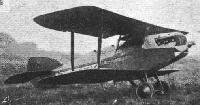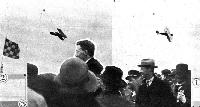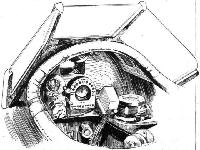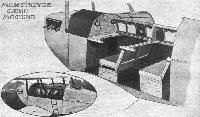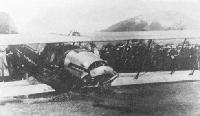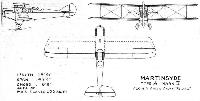
Варианты
- Martinsyde - F.3 / F.4 Buzzard - 1918 - Великобритания
- Martinsyde - F.4A / F.6 / A - 1919 - Великобритания
- Martinsyde - A.D.C.1 / Nimbus - 1924 - Великобритания
Martinsyde. Серия F
Варианты
F.4A: двухместный туристский самолет на базе F.4
Type A.Mk I: двухместный вариант с большой дальностью полета на основе F.4
Type AS.Mk I: вариант A.Mk I с поплавковым шасси
Type A.Mk II: конверсия F.4 с закрытой четырехместной кабиной перед открытой кабиной летчика
F.6: двухместная конверсия F.4 с переделанными крылом и шасси
A.V.1: один F.4A, доработанный для конструктора авиадвигателей Эмхерста Вилльерса
Описание:
- Martinsyde. Серия F
- Flight, July 1920
The Olympia Aero Show 1920 - Flight, August 1922
A MARTINSYDE FOR NEWFOUNDLAND
Фотографии
-
Мировая Авиация 185
Martinsyde A.Mk II с собственным именем "Big fella" стал первым самолетом Авиационного корпуса Ирландии. По назначению самолет был транспортом для экстренных ситуаций ирландского лидера Майкла Коллинза.
-
Air Pictorial 1969-06
Регистрационный номер: G-EAPI MARTINSYDE F.6. The F.6, produced by Martinsyde, Ltd. at Brooklands in 1920, was a development of the F.4 Buzzard, one of the fastest aeroplanes produced during the 1914-18 War, which had a speed of 145 m.p.h. The later aircraft was intended as a military two-seater, but was also produced as a single-seater. The engine normally fitted was a 300-h.p. Hispano-Suiza, although the 275-h.p. Rolls-Royce Falcon was an alternative. One F.6, G-EBDK, was fitted with a 200-h.p. Wolseley Viper and was flown into second place in the first (1922) King's Cup Air Race by Fred Raynham, at 104.7 rn.p.h. G-EAPI was the prototype, which has flown in the 1920 Aerial Derby by the company's test-pilot R. H. Nisbet, converted from an F.4. Span, 31ft. 11 1/4 in.; length, 24ft. 6 in.; maximum speed (single-seater with Hispano Suiza), approx. 145 m.p.h.
-
Flight 1920-07 / Flight
Регистрационный номер: G-EAQH Three-quarter rear view of the Martinsyde F4a, two-seater
-
Flight 1920-07 / Flight
THE MARTINSYDE F4A AT OLYMPIA: The four propellers are not mounted on the side of the fuselage to enable the machine to travel sideways, but are on a stand some distance in front of the machine
-
Aeroplane Monthly 1988-12 / Personal album. Civil
Регистрационный номер: G-ABKH [4] The Martinsyde A.V.1 G-ABKH at Hanworth in 1932. The last of a couple of dozen or so British civil-registered 'Tinsydes, 'KH was a two-seater externally identical to the F.4A. The engine and airframe, though, were much modified by ’KH’s owner, C. Amherst Villiers - hence A.V.1. Initially the 300 h.p. Hispano-Suiza-powered biplane was kept at Brooklands, until sold to Brian Field in October 1932, when it was based at the owner’s private field at Kingswood Knoll in Surrey. The A.V.1’s distinctive two-tone blue colour scheme is shown clearly in these photographs. G-ABKH remained airworthy until February 5, 1933.
-
Aeroplane Monthly 1991-05 / J.Havers - Field of endeavour (1)
Регистрационный номер: G-ABKH [4] Martinsyde F.4A G-ABKH was assembled by ADC Aircraft Ltd for C. Amherst Villiers and was sold to Brian Field in October 1932. It crashed at Bekesbourne on February 5, 1933 after an argument with a telegraph pole.
-
Aeroplane Monthly 1988-12 / Personal album. Civil
Регистрационный номер: G-ABKH [4] -
Aeroplane Monthly 1988-12 / Personal album. Civil
Регистрационный номер: G-ABKH [4] The Martinsyde A.V.1 G-ABKH at Hanworth in 1932. The last of a couple of dozen or so British civil-registered 'Tinsydes, 'KH was a two-seater externally identical to the F.4A. The engine and airframe, though, were much modified by ’KH’s owner, C. Amherst Villiers - hence A.V.1. Initially the 300 h.p. Hispano-Suiza-powered biplane was kept at Brooklands, until sold to Brian Field in October 1932, when it was based at the owner’s private field at Kingswood Knoll in Surrey. The A.V.1’s distinctive two-tone blue colour scheme is shown clearly in these photographs. G-ABKH remained airworthy until February 5, 1933.
-
Flight 1924-01 / Flight
A Christmas Greeting from Canada: This photograph is from a Christmas card sent us by the Laurentide Air Service, Ltd., of Montreal. The machines on the ice are a Martinsyde and a Westland.
Другие самолёты на фотографии: Westland Limousine - Великобритания - 1919
-
Flight 1923-08 / Flight
THE RACE FOR THE KING'S CUP: Photographs of the competing machines. Martinsyde F.6 (200 h.p. Wolseley "Viper").
-
Flight 1920-07 / Flight
The Martinsyde F.6, 300 h.p. Hispano-Suiza (No. 11), piloted by Mr. Nisbet in the Aerial Derby
-
Flight 1922-09 / Flight
Регистрационный номер: G-EBDK [3] THE FIRST THREE MACHINES HOME: Barnard's D.H.4A (the winner); Raynham's Martinsyde F.6; and Cobham's D.H.9B, lined up in front of the enclosures.
Другие самолёты на фотографии: De Havilland D.H.9B / D.H.9C - Великобритания - 1919
-
Flight 1924-08 / Flight
Регистрационный номер: G-EBDK [3] THE KING'S CUP: Three interesting machines at Hendon for the start. Left to right, Mr. Alan S. Butler's D.H.37 (275 Rolls-Royce "Falcon 3"), flown by Major H. Hemming; Mr. F. P. Raynham's Martinsyde F.6 (700 Wolseley "Viper"), piloted by himself; Mr. Douglas Vicker's Vickers "Vulcan" (450 Napier "Lion"), flown by Capt. S. Cockerell.
Другие самолёты на фотографии: De Havilland D.H.37 - Великобритания - 1922Vickers Vulcan / Type 61 - Великобритания - 1922
-
Flight 1930-01 / Flight
The classic and popular air race known as the Aerial Derby, inaugurated in 1912. At the photo is the "line-up" of competing machines before the start of the fifth contest, which took place in July, 1920. The machine in the foreground is. the Nieuport "Nieuhawk" piloted by "Jimmy" James, who finished second. Next are the two Martinsydes - the F.6 and the F.4.
Другие самолёты на фотографии: Martinsyde F.3 / F.4 Buzzard - Великобритания - 1918Nieuport & General Nighthawk - Великобритания - 1918
-
Flight 1922-08 / Flight
THE AERIAL DERBY: Martinsyde F.6, 180 h.p. Wolseley "Viper."
-
Flight 1926-07 / Flight
The King's Cup: This is the famous Martinsyde F.6 (200 h.p. Wolseley "Viper"), originally owned and flown by F. P. Raynham in previous races. Its new pilot will be Leslie Hamilton.
-
Flight 1922-08 / Flight
Регистрационный номер: G-EBDK [3] PROM THE AERIAL DERBY: F. P. Raynham taking off on his Martinsyde F.6.
-
Flight 1924-08 / Flight
FINISH OF THE RACE FOR THE KING'S CUP: 1, Barnard crossing the finishing line. 2, Raynham finishes two minutes later. 3, Chairing the winner. Towards the right-hand side of the picture Raynham may be seen smiling good-humouredly at the hoisting of his successful rival.
Другие самолёты на фотографии: De Havilland D.H.4A - Великобритания - 1919
-
Aviation Historian 10 / F.Merriam - Birds of a Feather /Echoes from Dawn Skies/ (5)
The Martinsyde Raymor was built specifically for Raynham and C.F.W. Morgan’s bid to claim the Daily Mail prize for the first non-stop transatlantic flight. Here Morgan clambers aboard as Raynham warms the engine just before their first failed attempt on May 18, 1919.
-
Flight 1920-07 / Flight
The "Martinsyde "A2" built to carry pilot and four passengers. This view shows the "open cabin" type
-
Flight 1919-12 / Flight
THE AUSTRALIAN FLIGHT: On the left, the start from Hounslow of the Martinsyde 'plane on December 4. "Goodbye-ee!" At top: Mr. Nesbit of the Martinsyde firm wishes good luck to Capt. C. E. Howell on his journey. On the right: The Martinsyde 'plane gets away at 9.35 a.m.
-
Air International 1985-12 / Fighter A to Z
The two-bay two-seat fighter version of the Buzzard supplied to Spain in 1921 as the F.4A.
-
Flight 1921-11 / Flight
MARTINSYDES FOR SPAIN: One of Martinsyde F.4a (300 h.p. Hispano) two-seater biplanes recently supplied to the Spanish Government. A representative of the Spanish Government was at Brooklands, and made a trip in each of the machines before taking delivery.
-
Flight 1922-08 / Flight
THE MARTINSYDE TYPE A, MARK II: Three-quarter front view.
-
Flight 1920-07 / Flight
THE MARTINSYDE CABIN MACHINE, MARK A II AT OLYMPIA: A gauze roof affords ample ventilation of the cabin
-
Aviation Historian 26 / D.Septer - "Pilot Wanted. Plenty of risk, Good pay..."
Fitted with floats, Cotton’s first Martinsyde Type A Mk II (right) stands alongside G-EAQP, the weary D.H.9 he inherited on his arrival at Botwood.
Другие самолёты на фотографии: De Havilland D.H.9B / D.H.9C - Великобритания - 1919
-
Aviation Historian 26 / D.Septer - "Pilot Wanted. Plenty of risk, Good pay..."
While back in the UK in 1921 Cotton purchased the first Martinsyde Type A Mk II to be built, c/n 215, which arrived at Botwood in November 1921 and bore no identification markings as it was operated only in Newfoundland and not placed on any civil register. It is seen here at St John’s being prepared for its first air mail run.
-
Aviation Historian 26 / D.Septer - "Pilot Wanted. Plenty of risk, Good pay..."
Martinsyde c/n 215 at Cartwright, Labrador, in March 1922. The Type A Mk II was a four-passenger cabin two-bay biplane with an open cockpit for the pilot. Equipped with radio, cameras and a readily interchangeable undercarriage arrangement for wheels, skis or floats, it was eminently suited to seal-spotting in Newfoundland.
-
Aviation Historian 26 / D.Septer - "Pilot Wanted. Plenty of risk, Good pay..."
Martinsyde c/n 215 and Limousine III G-EARV outside the hangar at Botwood circa early 1922. Thanks to engine covers made from balloon fabric to Cotton’s own design, “our aircraft would stay for days on end in temperatures of from 30 to 50 below zero, but when we pulled our covers off, the engines would start up immediately”.
Другие самолёты на фотографии: Westland Limousine - Великобритания - 1919
-
Aviation Historian 28
Cotton in the rear cockpit of silver-decked original Martinsyde c/n 218.
-
Flight 1922-08 / Flight
THE MARTINSYDE TYPE A, MARK II: On the left the engine housing, and on the right the cabin, pilot's cockpit, etc. The front compartment contains the wireless set. The pipe which can be seen inside this compartment is a hot air pipe from the engine housing, carrying heated air to the cabin.
-
Flight 1922-08 / Flight
The Martinsyde Type A, Mark II: Sketch of the pilot's cockpit, showing instrument board. In the centre of the board may be seen the tell-tale lights of the Vickers-Reid gyro turn indicator.
-
Aviation Historian 26 / D.Septer - "Pilot Wanted. Plenty of risk, Good pay..."
In the summer of 1922 Martinsyde invited the British aviation periodicals to examine Cotton’s second Martinsyde Type A Mk II before it was shipped to Newfoundland, supplying artworks of various aspects, including the passenger accommodation (LEFT) and the cockpit (ABOVE). The radio equipment was fitted in the hatch forward of the cabin. The cockpit panel was dominated by the Vickers-Reid illuminated gyro turn indicator. The cockpit windscreen was designed by Cotton himself.
-
Flight 1922-08 / Flight
The Martinsyde Type A, Mark II: Diagrammatic perspective view of the cabin, which has seating accommodation for four passengers. The deck fairing in front of the forward compartment contains the wireless outfit, and in the floor of the compartment is a mounting for an aerial camera. The hinged cabin roof is covered with gauze to ensure ventilation.
-
Flight 1920-11 / Flight
MODERN CABIN MACHINES: The Martinsyde A.II.
-
Aviation Historian 28
Sidney Cotton's crash in St John's, Newfoundland, after a downturned skid caused Martinsyde Type A Mk II c/n 215 No 8's nose to dig in. Note the "Aerial Survey Co, Newfoundland" lettering on the cowling.
-
Air Enthusiast 2006-03 / C.Curry - Another Alcock Album /Pioneering day/
The Martinsyde 'Raymor' after its crash on the third attempt at a takeoff. The crosswind was too strong to allow it to take off fully loaded with oil and fuel for the transatlantic flight. Morgan was injured by glass from the broken compass and had to go to hospital, Raynham was OK and with the Martinsyde crew tried to rebuild the aircraft for a second attempt at the flight.
-
Flight 1920-07 / Flight
SOME MARTINSYDE DETAILS: The strut attachment on the F4A.
-
Flight 1920-07 / Flight
Martinsyde F.4.A
-
Flight 1920-07 / Flight
Martinsyde A II
-
Flight 1922-08 / Flight
Martinsyde Type A Mark II 275 h.p. Rolls-Royce "Falcon"
- Фотографии









